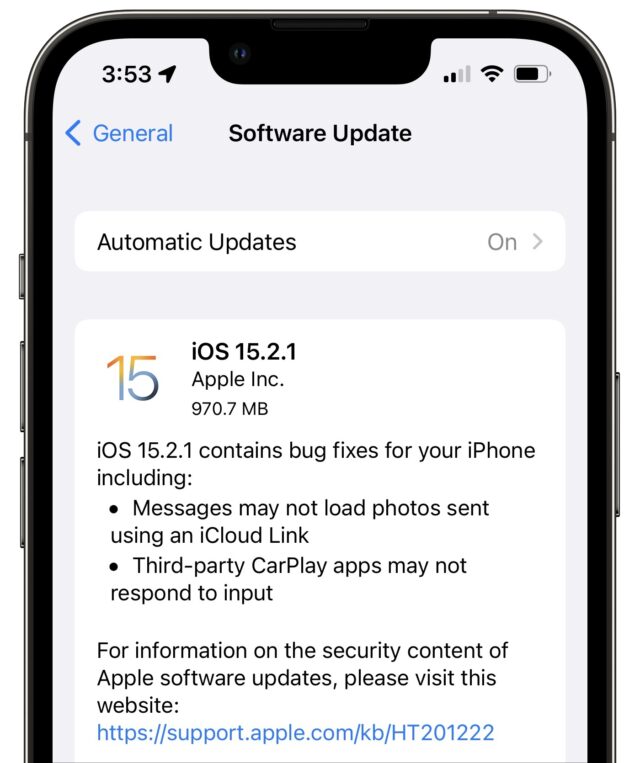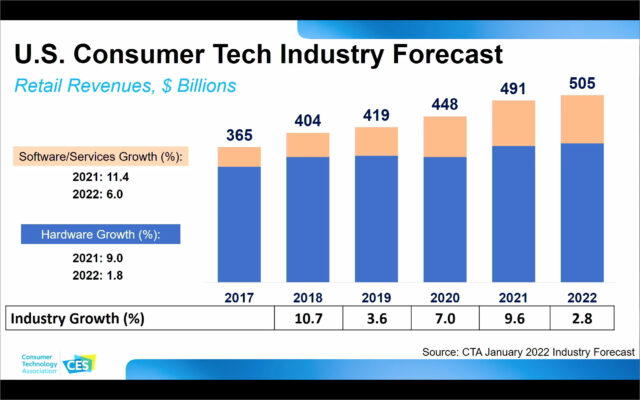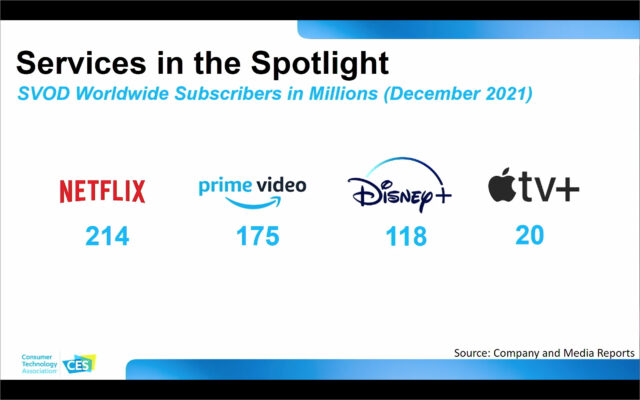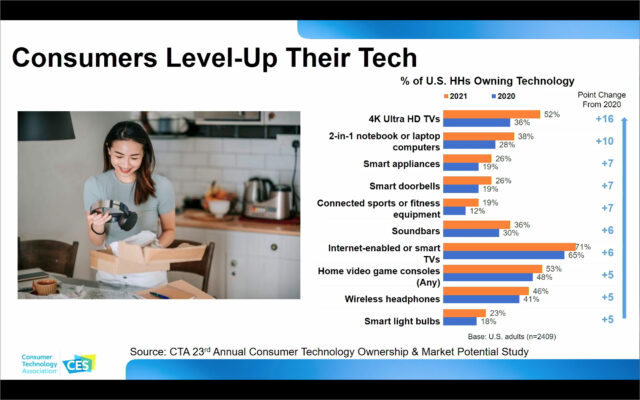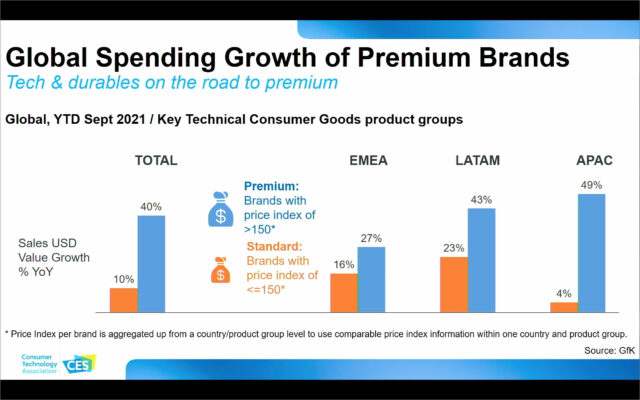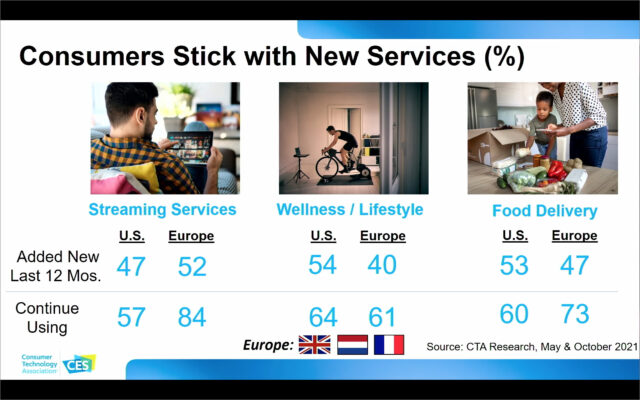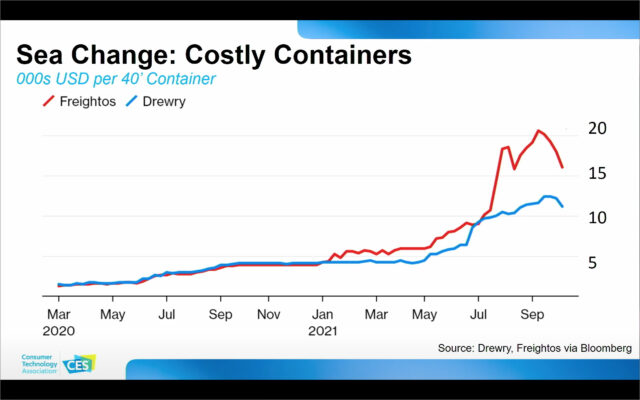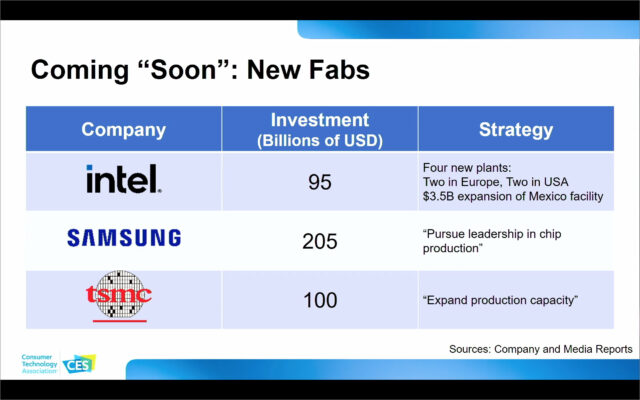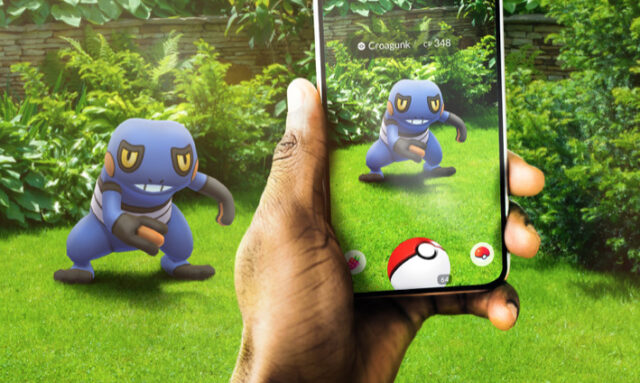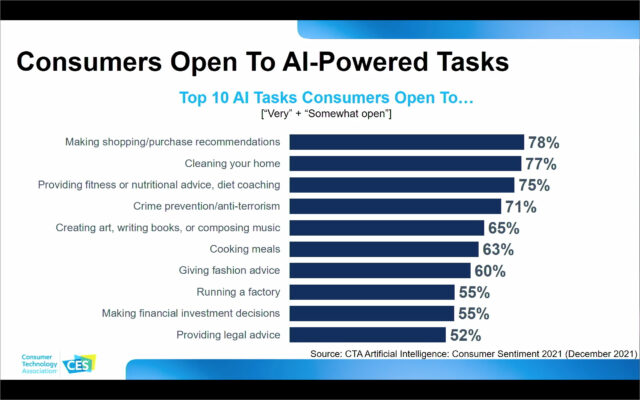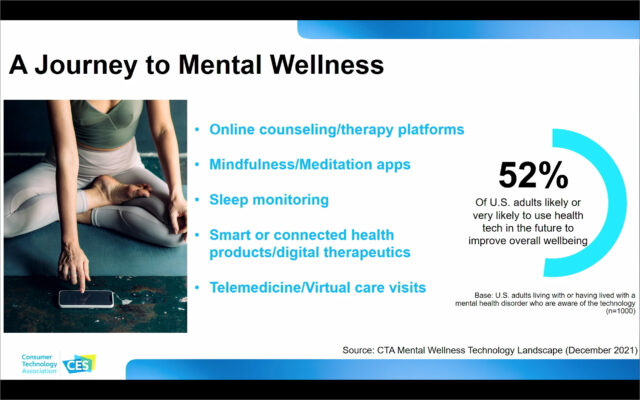#1594: iOS 15.2.1, AirTag stalking, CES Tech Trends for 2022
Last week, Apple rolled out iOS 15.2.1 and iPadOS 15.2.1 to fix a nasty HomeKit-related vulnerability and patch a few small bugs. Police departments and the media have been abuzz with reports of Apple’s AirTag location trackers being abused by stalkers and thieves. Glenn Fleishman examines the concerns to see if they’re real or overblown. Finally, Jeff Porten is back from his virtual trip to CES in Las Vegas to share the Consumer Technology Association’s thoughts on—and his reactions to—tech trends to watch in 2022. Notable Mac app releases this week include Mactracker 7.11.1, HandBrake 1.5.1, Default Folder X 5.6.3, Fantastical 3.5.2 and Cardhop 2.0.8, Mimestream 0.32, SoundSource 5.3.9, ScreenFlow 10.0.4, Mellel 5.0.9, Bookends 14.0.4, and Microsoft Office for Mac 16.57.
iOS 15.2.1 and iPadOS 15.2.1 Fix Messages Bug and HomeKit Vulnerability
Apple has released iOS 15.2.1 and iPadOS 15.2.1 updates, with just a couple of bug fixes:
The more interesting change appears in the security notes. There’s a single security fix for a nasty HomeKit vulnerability, in which a maliciously crafted HomeKit accessory name (containing some 500,000 characters) could cause iOS and iPadOS devices that loaded it to be disrupted, even after rebooting—the only solution was to reset and restore the device. Security researcher Trevor Spinolas reported the bug to Apple way back in August 2021. Unusual though the vulnerability may be, it’s distressing that it took Apple as long as it did to acknowledge and fix the bug—Apple only benefits by treating security researchers well.
If you use HomeKit or have been affected by the Messages or CarPlay bugs, you should update right away. Otherwise, we recommend waiting a few days to see if any issues crop up.
You can install the iOS 15.2.1 update (804.8 MB on an iPhone 11 Pro) and the iPadOS 15.2.1 update (676.6 MB on a 2020 iPad) in Settings > General > Software Update.
AirTags: Hidden Stalking Menace or Latest Overblown Urban Myth?
The plural of anecdote is not statistics. In the absence of hard data, however, anecdotes often stand in. That seems to be the case with the risk of unwanted tracking associated with Apple’s AirTags, cited in several recent news stories and some police reports as a vector for stalking and car theft.
If we take all reported incidents at face value, the total known incidents number no more than a couple dozen across the United States and Canada. Why the outrage and heavy coverage? The fear of what’s known is just the tip of the iceberg. That’s normal anxiety in regular times and accentuated in a pandemic era, in which our calibration is so far off it can be hard to understand how to judge risk and reaction.
Tracking the Unknown
Let’s review how an AirTag and the similar Chipolo ONE Spot work (see “Apple’s AirTag Promises to Help You Find Your Keys,” 20 April 2021, and “Chipolo Ahoy! The ONE Spot Find My Network Tracker Arrives,” 24 August 2021). These small, low-power Bluetooth-based items continuously broadcast an encrypted Bluetooth identifier that can be picked up within a range of up to hundreds of feet by Apple devices running recent operating systems. The Bluetooth ID changes at regular intervals to avoid reverse tracking: a static ID would allow someone to track the broadcasting item. (Apple adapted this approach for the system that it and Google provide for COVID-19 exposure tracking.)
Any Mac, iPhone, or iPad with an Internet connection and the Find My network enabled combines its currently known location with any Bluetooth network identifier that fits the pattern for a Find My item. This pairing of location data and Bluetooth ID is uploaded to Apple. Apple can’t use those location pings to determine the identity of any given device because the Bluetooth ID encryption allows only a native Find My app that’s part of an iCloud-linked account to request and decrypt the data. All AirTags and Find My items are paired using a single iPhone or iPad, and their encryption keys are shared among that user’s other devices.
Because of its compact size, intermittent Bluetooth transmission, regular ID change, automatic signal relaying, and long battery life, an AirTag would seem to be an ideal device to track someone without their knowledge. And it would be, except for the safeguards Apple has put in place to alert people who have an AirTag near them. I wrote an article that describes all the cases in which someone is alerted—see “When You’re Told an AirTag Is Moving with You” (4 June 2021). In brief:
- If an AirTag or other item relays consistently through your iPhone or iPad as you move across locations, you should receive an alert. That alert provides a lot of advice to the device owner about how to proceed.
- An Android user with Apple’s new Tracker Detect app installed can manually scan to detect AirTags and Find My items near them, but only on demand—not in the background as with iOS and iPadOS.
- After a random interval between 8 and 24 hours apart from an owner’s devices, a Find My item will produce a loud noise at regular intervals.
Those safeguards leave a fair amount of room to squeeze around the edges of notification. As I described in “13 AirTag Tracking Scenarios” (15 May 2021), a malicious person could put a tracker in a vehicle or bag owned by a partner and ensure that partner’s iPhone had the Find My network disabled. As long as the vehicle or bag was back near the stalker within about 8 hours, its alarm might never go off.
The issue of unwanted tracking is exacerbated by the squishiness around nearly every aspect of AirTags. We don’t know how many AirTags and similar Chipolo ONE Spot Find My trackers have been sold. We don’t know the number of alerts people receive daily about trackers traveling with them. Of that number, we don’t know how many are false positives: the times that a tracker incidentally near someone provokes an alert that has nothing to do with them.
Most important, we don’t know what number of Find My trackers are being used to attempt to track adults or non-custodial children without their knowledge and consent. (The issue of tracking your children or those you have guardianship over gets into more complicated legal issues that vary by state.)
What do we know?
- It’s feasible to use AirTags to track someone without their knowledge. It’s cheap and easy, but fraught with the chance of discovery and tracing it back to the AirTags’ owner.
- Police and individuals have found AirTags hidden in vehicles a few times.
- Police don’t quite know how to deal with reports by individuals who suspect they are being tracked.
- A fair number of media reports and some police announcements make a lot of assertions; the worst start to verge on common urban myths that play on deep-seated fears.
Let’s look into the media and police reporting.
A Roundup Reveals We Should Round Down
I’ve assembled several stories from the last few weeks, as seemingly credible accounts appeared of people believing that someone was either actively tracking them or had done so at one time. (Simultaneously, I’ve started seeing more people sharing first-hand experiences of using AirTags to recover lost and sometimes stolen stuff.)
The biggest flurry of stories and subsequent reporting emerged from the York Regional Police in Ontario, Canada, who said that, in what they believed were five different incidents, car thieves hid an AirTag on an expensive vehicle in a public parking lot in order to find it later at an owner’s home and steal it at their leisure.

The department posted this video to Twitter and a media release on their website (Internet Archive link) with a more detailed description and photos. (The release is no longer available, but this isn’t a retraction: the tweet is still up, and the York police appear to remove their posts consistently within four weeks, likely automatically.)
That was 2 December 2021, and several stories followed with specific incidents:
- A swimsuit model found one in her coat pocket: Brooks Nader explained on her Instagram account that she had received a warning about an AirTag traveling with her as she moved among bars one night and then headed home.
- Man finds Apple AirTag tracker on his Dodge Charger (Detroit, MI): This TV station has a single first-hand account. It also quotes local police anonymously with a story that’s suspiciously like the York release: “Thieves track the target vehicle and pick the most opportune time to steal—found mostly on Dodge products, parked in mall parking lots.”
- West Seneca Police warn of Apple AirTags being hidden on cars and Apple’s AirTags used to follow 2 women in West Seneca (West Seneca, NY): The West Seneca Police cite two cases and found a hidden AirTag in one of them.
- Crowley Police: Apple AirTag facilitating crime (Lafayette, LA): A local police chief asserts two cases with “a notification” but provides no details.
- Burlington Police give warning about Apple AirTags (Burlington, IA): “Police say they are getting calls from people who have received notifications on their phones that they have been air tagged and it will show them their route of travel.”
- Are Apple AirTags Being Used to Track People and Steal Cars?: This prominent end-of-year story in the New York Times had more smoke than fire, asking a question instead of making a statement. The story features several first-hand accounts but includes Mary Ford, “a 17-year-old high school student from Cary, N.C.…[who] realized it wasn’t a threat when her mother revealed she had put the tracker in the vehicle about two weeks earlier to follow her daughter’s whereabouts.” But “[Ashley] Estrada, who got the notification while in Los Angeles, eventually found the quarter-sized tracker lodged in a space behind the license plate of her 2020 Dodge Charger.”
I also found more general pieces that combined raising awareness and promoting general anxiety:
- Police warn of AirTags used to track people instead of items (Jacksonville, FL): Despite stating the police warning, this story doesn’t quote any police officers or leaders.
- Is it legal to track people using AirTags in Alabama? (Huntsville, AL): “The Huntsville Police Department says they have not had any cases of AirTag stalking yet.”
- Some Atlanta residents being tracked with Apple AirTags: “We uncovered eight police reports in our area, most within the last month…” the news station said, which could include people receiving false positives. But one person was definitely tracked via her vehicle across a long drive.
The most sensible accounting came from the University of Wisconsin’s police department in its post, Apple AirTags and Your Safety. The blog reports that “UWPD has had three reports of individuals reporting they’ve received an AirTag warning message in the past few weeks on the UW-Madison campus.” But it continues with a very important proviso: “In every instance, the AirTag could not be located… it’s very likely the AirTag signal was being picked up from a nearby apartment or residence hall room rather than the individual being maliciously tracked.”
Are people overreacting? No: the message is absolutely disturbing. If I were in a situation where I suspected someone might have followed me from a bar, from my place of work, or from school, I would absolutely call the police. And I’m a straight man—if you identify as a gender other than male and an orientation other than straight, I expect the sense of concern would be vastly higher due to the well-documented heightened risk of stranger, domestic, and ex-partner stalking and violence among the 70% or so of the population that covers.
But wait. If these incidents were happening regularly, I would expect to see an explosion of news stories. The AirTag offers a specific alert; finding one provides an actionable element for police, who are accustomed to GPS trackers being hidden on cars for stalking purposes. Reporting an alert might not get an officer excited, but finding an AirTag would certainly warrant a report. In some of the stories above, police even began or completed the process to obtain the registered information associated with the AirTag. In theory, that should lead to a culprit, and the news media should be following up on these stories.
Remember, AirTags are locked to an iCloud account, are associated with a phone number, and have an immutable serial number inside. To read the serial number, someone finding an AirTag only needs an NFC-capable Apple or other device; with other Find My items, an iPhone or iPad is required. All this would seemingly add up to making an AirTag a high-risk way for a perpetrator to track someone unless they had the foresight to create a burner Apple ID and potentially use a burner iPhone that could otherwise be tracked by its unique cellular ID. Apple may promise privacy for iMessage and a lot of other data, but the company will reveal via warrant things like to whom an iCloud account belongs.
Some of the reporting and the police statements smack of past panics and recurring urban myths. In the 1980s, law enforcement across the United States was convinced Satanism was rampant with human sacrifice, including the murder of infants. No matter that no adults or babies were missing—Satanist! From the Chicago Tribune in 1987:
But to a growing number of police investigators around the nation, stories of ritual mutilation, blood-letting and sometimes murder are all too real. In seminars and conferences, they have begun to train others to see signs of satanic motives behind otherwise bizarre and inexplicable crimes.”
Similarly, police alerts appear every year around Halloween about razor blades in apples or poison in candy, even though only four cases were reported between 2008 and 2019 in the US and almost none before that. A prominent 1974 candy poisoning story wasn’t random: a father murdered his child. There’s also the ongoing hoax of LSD-coated stickers intended for children. And the one about how flashing your brights at someone with their headlights off at night will lead them to follow you and kill you as part of a gang initiation despite no deaths ever reported this way. (Road rage is something else.)
It’s human to tell stories. It’s human to manifest fears within the modern world as expressions of distrust of technology. And there’s definitely a risk with Find My trackers that you could be tracked in a way vastly easier than with any previous device. Being aware can help, and Apple could do more.
Keep Alert for Trackers
If you’re worried, what reasonable efforts can you take to protect yourself and your loved ones against unwanted tracking?
- Leave Find My enabled: If you disable the Find My network, you won’t receive warnings that an AirTag is moving with you. (Conversely, disabling it prevents your device from relaying, but the value in receiving warnings is very high.)
- Pay attention to alerts: Apple’s alerts and explanatory details are clear and informative—read them and follow the provided links. No specialized knowledge is necessary to understand Apple’s instructions for finding and disabling Find My items.
- Listen for odd alarm sounds: Find My separation alarms are designed to alert people to the tracker’s presence—if you hear something odd, listen carefully and look for it. The alarm may be faint if someone has tried to muffle the sound.
- Explain the basics of Find My to others: Help those who know little or nothing about technology or the tech industry to learn what an AirTag is and what to do if they receive an alert or hear a sound.
- Contact authorities, if it makes sense: Upon finding an AirTag, if you have any doubts about your safety and you trust that law enforcement could improve on that, file a police report so the authorities can investigate further with Apple.
One thing that’s out of our control? Active scanning for nearby Find My items. It’s quirky that you can force a scan of your vicinity for Find My devices from an Android phone, but you can’t do the same from a piece of Apple hardware. In the iOS 15.2 beta, an item in the Find My app’s Items view read Items That Can Track Me, appearing to offer Tracker Detect capabilities. It didn’t ship in the production release of 15.2, but Apple should make sure it’s in an upcoming release. This would allow iPhone and iPad users to check their car, bags, or home if they’re concerned. (And Tracker Detect for Android should work automatically, as the Find My app does in iOS.)
Fundamentally, we can’t keep people from engaging in bad behavior. Before wireless technology, someone could have attached a can of flour to the back of your car, punctured it with a small hole, and followed the trail of white powder through the streets. Relatively expensive GPS trackers that are more powerful and don’t require relaying abound. An abusive or mistrustful partner might simply use Find My via Family Sharing to see your iPhone or MacBook’s whereabouts.
AirTags don’t offer a new kind of risk. They’re just a new and ill-understood entry in an old game that might encourage some people to go farther than is sensible or legal with regard to tracking other people. Apple should continue to refine parameters around the AirTags to favor safety while still making them useful for finding a lost backpack or keys.
CES 2022: Another Year, More Tech Trends
You may be forgiven for feeling as though it has been ten years since last January, but in truth, only a year has passed—and that’s long enough for another CES to be underway in Las Vegas. As usual, the show begins with two Media Days with information for the assembled press; as per “the new usual,” these events and a portion of the rest of the show is being broadcast in hybrid format online. I was exceptionally unhappy with last year’s CES online format (see “CES 2021: Multi-Port iPad Cases, MacBook Pro SSDs, Videoconferencing Cameras, and a Plane You Can Drive,” 11 February 2021), and so I’m equally unhappy to be one of the people attending virtually. But given the forthcoming tidal wave of Omicron COVID-19 cases (which I wish to neither contract nor spread), as well as the thousands of flights canceled in the week I would have been traveling, it seemed wise to log in to CES remotely for another year.
One highlight of Media Days is the Consumer Technology Association’s Tech Trends to Watch presentation. It’s irrepressibly upbeat and staged to spin the positives of consumer tech, as one might expect, but it always contains interesting numbers. But there was a big dog in the room that wasn’t barking: this year’s presentation said much less about COVID-19 than I expected. Steve Koenig, CTA’s Vice-President of Research, who gave the presentation as usual, referred several times to “the season of the pandemic,” which makes me wonder if he spends too much time in Westeros, where the seasons span many years. Two years into the closure and partial reopening of… let’s call it Earth, only 62% of Americans are fully vaccinated and 21% have had booster shots; worldwide, those numbers are 51% and 7%, respectively.
The last two years were enough time for two highly infectious COVID-19 variants to emerge, while the unvaccinated population acts as a reservoir and spread vector for new ones. Given these facts and vaccination numbers, I don’t see a clear future boundary line at which point we can declare Mission Accomplished! and call the pandemic over. Instead, I expect we’ll settle into a semipermanent new normal as communities continually adjust to pandemic rates just as they do to changing climate. This recognition was absent from Koenig’s presentation, which struck me as a glaring omission considering how vital technology has been in our societal adaptation to the pandemic. I would have been much more reassured by a statement along the lines of, “This is how we see the pandemic developing over the next few years, and these are the actions we see the tech world taking to ameliorate its impacts.”
The Tech Economy Is Just Fine, Thanks
We might all be spending more time at home, but many of us have money to spend, and we’re spending it on tech. Consumer tech sales are forecast to pass the half-trillion-dollar mark in 2022.
Not highlighted in Koenig’s presentation, but striking in the bar chart, is that it seems that hardware sales increases have been small over the past five years—the real action is in software and services. Or, to rephrase it in consumer terms, how often do you buy a new TV set versus how often do you subscribe to a new streaming service? And have you accelerated that spending since the pandemic changed your habits? Koenig specifically drew attention to this segment in a later slide, with the top four streaming services ranging from 20 million to over 200 million subscribers.
Note that these numbers may not be directly comparable. Amazon’s Prime Video has 175 million subscribers by dint of Amazon Prime delivery services having the exact same number; the two services are bundled and can’t be purchased separately. The number of Prime viewers is almost certainly a fraction of its claimed subscribers. Likewise, Apple TV+ numbers are bumped up by anyone who purchased an Apple device and turned on the 90-day trial, and anyone opting into an Apple One service bundle. Only Apple knows how many of its subscribers are viewers—or how many show up only when new Ted Lasso episodes are airing. Compare with Netflix, the juggernaut with 214 million subscribers and a name that has almost become a generic verb for watching a streaming service, and Disney+, which has reached 118 million subscribers after only two years in operation with a much less diverse back-catalog of shows—although obviously, highly desirable ones.
Koenig proposed that consumers are “leveling up their homes” with new technologies in response to the pandemic, but I don’t see a rosy picture for hardware sales in the next slide.
The biggest jump here is in 4K TVs, but I wonder whether that’s people who set out to upgrade their TV to a higher resolution or who simply decided it was time to buy a new TV of whatever quality and found that 4K TVs fell within their price range. (Especially considering how many people’s price range expanded from money not spent on eating out and going to theaters.) It paints a different picture depending on whether consumers are seeking out high-tech options for their electronics, or if they’re taking those options because they’re now standard, or even unavoidable, in the price ranges they’re willing to buy. You may not want wireless headphones, but buy a recent iPhone and that’s what you’re going to be using.
Similarly, it may sound exciting that 40% of Europeans are planning on a smartphone purchase in the next year, and 27% of them will buy a new desktop computer—but that is also what you’d find if both categories had no new customers and existing ones replacing their current gear on a 2.5–4 year cycle.
There are, however, two genuine bright spots in CTA’s numbers for the tech industry. The first is that by the measures CTA has formulated for what constitutes a “premium” expensive brand versus a “normal” midrange brand, premium sales are far more robust worldwide. Koenig said that this is about consumers seeking a higher-quality experience—not a hard argument to make here in TidBITS with an audience of Apple customers. But I suspect other factors are in play, and you might agree if you share my cynical view that more expensive devices are not always better.
Put simply, there have been many winners and losers in the pandemic economy, and some people who have disposable income have much more of it now, while other people have had their income completely disrupted. I suspect that worldwide, it might be that if someone has the money to spend on technology at all, they have enough to buy premium brands for their prestige factor alone—leaving a much smaller budget sector and hence much flatter sales for technology competing on price. That’s bad news for companies selling commodity tech, but it’s very good news for innovators, cutting-edge R&D products, and design influencers, whose products hit the market with stiff premiums. It’s healthy for technology to have those high-risk sectors well-supported; this year’s cutting-edge is 2027’s mainstream.
The other bright spot is that people who adopt new services and software tend to stick with their categories. Most likely, you might have tried several streaming services and abandoned a few once you decided what mix of shows you want to watch, but you didn’t stop paying for streaming services entirely. This is also true for fitness technology and food delivery services, both of which saw a major bump during the pandemic that isn’t likely to go away.
And I can attest, in other areas. I no longer pay attention to which of my Mac apps are licensed through Setapp (see “Setapp Offers Numerous Mac Apps for One Monthly Subscription Fee,” 25 January 2017), and I only noticed during the brief period I was transitioning from a MacBook Pro to a new M1-based MacBook Air since my subscription only allowed those apps on a single Mac. This kind of invisibility, where the service subscription fee is seen as a sunk cost and the service itself becomes intrinsically integrated into particular hardware, guarantees recurring revenues for those companies.
You Have Nothing to Lose But Your Supply Chains
Even the best technology in the world won’t do you any good if you can’t get it at any price. It’s not just about whether there’s a microchip available for your new truck; as with my decision not to go to Las Vegas, it’s also about whether there’s a sufficient workforce to plug in that chip (or keep planes in the air).
There’s remarkable fragility in the interwoven web of commerce that fuels modern society. The pandemic disrupted both the production of new widgets and our ability to get them where they were needed. Many people only became aware of the global shipping industry when a very large ship took a very bad turn in March 2021, but the fact is that a frighteningly large portion of our economy rests on our ability to get things where they’re needed at the time they’re needed. Remove some of the workforce necessary on docks and ships due to illness, and those disruptions ripple both up and down the supply chain. Of course, the same problem can occur in factories. In the case of microchips, in late 2020, it took 12 weeks for a commercial-size order to arrive; a year later, that delay had increased to 22 weeks.
Meanwhile, the price you’re paying in stores is frequently based on what has in the past been negligible per-item shipping costs. Those costs are much less negligible these days, as part of the driver for the current rate of global inflation is a doubling or tripling of the cost to move a giant metal box of widgets across oceans.
Koenig said that while the shipping cost problem was unlikely to change soon, he expected that other issues would be resolved by adding new technologies to the problem at the enterprise level. But then he disturbingly referred to using autonomous trucks instead of drivers, or robots instead of humans in factories. These ideas aren’t necessarily problematic in and of themselves—indeed, in the long run, they’re almost a certainty.
But are they something we should look to as a quick solution to our current problems? There are 3.5 million truckers in the United States alone, supporting many other industries (think of every roadside motel, restaurant, and small-town economy near a highway). We may indeed have the technological capability to switch to self-driving vehicles in a few years (according to what I’ve heard at CES and elsewhere over the last decade or two), and it’s likely true that there will be major economic benefits when human driving becomes a hobby that isn’t allowed in cities or on interstate highways. (If you think that’s disruptive, keep in mind that the technology that cars replaced was 6000 years old.) But it will likely be a decade or two before we have the political and social will to take humans literally out of the driver’s seat.
The more reliable solution, which is also being pursued, is to improve manufacturing capacity and factor shipping disruptions into future supply chain planning. The microchip deficit won’t be solved quickly, but three major chip fabricators—Intel, Samsung, and TSMC (the manufacturer of Apple’s M1 chip series)—have announced a total of $400 billion in investments in new factories, contributing to a total expected increase in manufacturing capacity of 16% in 2022. Better still, some of these factories will be spread out globally—as opposed to the current situation where 75% of fabs are located in East Asia. The current situation leaves us all vulnerable to a single large disaster that could take out multiple factories at once. This has happened in the past, as the one-two punch of 2011’s earthquake and tsunami in Japan and later flooding in Thailand impacted the supply of RAM chips and hard drives, respectively.
I Met a Verse I Didn’t Like
The presentation moved on to augmented reality and virtual reality (AR and VR), a perennial CES topic that has grouped both technologies under the term XR until this year. Virtual reality is what you might expect: the experience of putting on goggles or a head-spanning headset and being presented with a completely different reality, such as a video game or a walkthrough of a store distant from where you are now. Augmented reality is different: it takes information from your physical environment and overlays new information on top of it while still showing you your surroundings. Good examples of augmented reality include Google Live Street View, which shows arrows pointing in the right direction levitating in mid-air over the street, and Pokémon Go, a once-ubiquitous and still quite popular game where you can see critters showing up on your phone that—despite the illustration below—are decidedly not in your backyard.
Proponents of AR—of which I am one—expect that the technology that will make it ubiquitous is some kind of unobtrusive headgear that shows you an augmented picture of your surroundings without making you look like you just beamed in from the Enterprise. Such a device doesn’t yet exist for either AR or VR. VR devices like the Oculus Quest 2 headset are laudable for what they can do in smaller packages than in the past, but they are decidedly not unobtrusive. Still, as with most years at CES, even a cursory review of exhibitors reveals a raft of small companies that promise a lightweight glasses-only XR future—just as soon as a major manufacturer licenses their technology for several years of development. Despite this lack of hardware, Koenig said that the “basic building blocks” of XR are available: mobile devices with CPUs that can handle the calculations in real-time, haptics to give feedback other than audiovisual, and 5G (presumably to allow for a future when XR content is sent by devices other than the one in your pocket).
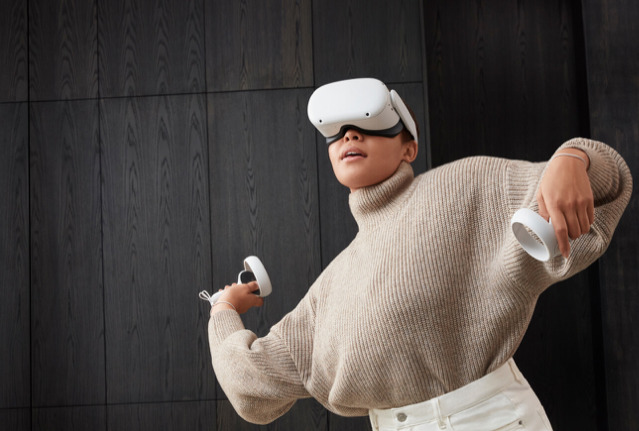
Disturbingly, at no time did Koenig use the term XR. Instead, he referred to this collective group of technologies as the “metaverse,” a term which most of us heard for the first time when Facebook changed its corporate name to Meta. Apparently, the CTA is another organization that wants the metaverse to become the accepted term for all extended reality experiences because Koenig simply used the word without explaining or defining it, as if it was already generally accepted by the audience. (The Verge has a particularly amusing and cynical Q&A about the metaverse that shows just how amorphous the concept remains.)
I find this troubling for two reasons. The first is that it’s inaccurate: the prefix “meta” means that what follows is about something else. The metadata for a file on your Mac includes its last-modified date and its size in megabytes; it’s data about data. Virtual reality isn’t about your local reality; it’s a temporary replacement for it. Augmented reality can be metadata—such as a heads-up display of the temperature where you’re standing—but it’s more likely an overlay of information not directly derived from your surroundings. The name of the restaurant you’re looking at might be considered metadata; a Pokémon Go critter fluttering outside is not.
This distinction between metadata and overlay data might seem pedantic, but it becomes profound when you consider that metadata is essentially optional, whereas overlay data is essentially… essential. The more society and the economy start moving experiences into an augmented realm that requires overlay data, the more people will be left out if they can’t afford or don’t want the necessary technology to access it. Have you been to a restaurant with QR codes on the tables, where all the ordering is online? This pandemic adaptation, common in my area, makes it harder to eat out without a charged phone and adds a technological layer to what was previously a purely social process. It’s an existing example of what could happen when augmented reality becomes common and requires expensive gear. Koenig said that the experience of the metaverse will become “inextricably” linked with physical reality. I think he’s right, and I think it will operate in both directions—miss out on the extended reality of your surroundings, and you’ll miss out on key aspects of your society.
“Metaverse” is a rebranding of something for which we already had terms: XR most recently but also dating back to 1982 with the word “cyberspace” in William Gibson’s Neuromancer. “Metaverse” itself is also an old word, dating back to 1992’s Snow Crash by Neal Stephenson, but it never entered the mainstream like cyberspace. Typically, corporations promote new words when we already have perfectly cromulent ones because they want to own them. Cyberspace and XR are virtual places where community and public spaces might exist; a metaverse is intellectual property where communities are owned, like on Facebook. When a $925 billion company changes its name to make you associate it more with a technology space that’s still years off, that’s not done lightly—and it’s not done without investing in the idea that Meta, Inc. is going to own a metaverse in the same way that Facebook owns a public square with 2 billion inhabitants.
Pardon me for possibly sounding utopian, but in my view, it’s crucial for a society to have public spaces uncontrolled by commercial entities. The Internet became what it is only because no one owned it, which inspired thousands of companies and open-source programmers to create an interoperable cyberspace that could be extended and inhabited by anyone else. To me, a future where multiple non-interoperable metaverses are instantiations of intellectual property is dystopian—will the experience of visiting Facebook Paris be radically different from Google Paris and Apple Paris, or just plain unmediated Paris? That’s certainly possible.
If you think I’m reading quite a lot into a single word, consider that Koenig wasn’t just selling metaverses; he also said that “crypto[currency] is the coin of the meta realm.” There was no other data to substantiate this extraordinary claim. Even if you’re an investor in Bitcoin or some of its thousands of competitors, it’s quite unlikely you’ve used any in commerce. As I write this, the value of a Bitcoin has dropped 3.2% today and 11.8% in the past week, while being up 23.1% overall in the last six months. That’s a highly volatile currency of a terrifying economy, possibly based on Dutch tulips, and while it might be fun to visit, I wouldn’t want to live there.
There was one thing Koenig said about the metaverse that I agree with: “We’ll be talking about this for the next 20 years.” Yes, and I hope that’s long enough for us to come to some agreement about how this technology can change our societies before we adopt it wholesale.
This Year’s Future Is the Same as Last Year’s
Otherwise, Koenig’s presentation said many things familiar to annual attendees of Tech Trends, which is to say, the future wasn’t here last year and it’s not yet here now. 5G communications are the “connective tissue” for the next decade, just as they were last year. What’s potentially new is that in 2022, the 3GPP working group will be coming out with a new set of requirements for 5G that will add additional standards for the industry. That’s unlikely to affect you directly, but it could help Koenig’s assertion that 5G will be revolutionary for how enterprises do business, both with each other and internally.
Artificial intelligence is such a CES regular that even Koenig called it a “perennial.” Even so, I was intrigued by CTA’s study about what tasks consumers would be willing to have performed by AI. The data describes a population that is, in my view, deeply uninformed about the risks and rewards of AI technology. At a Yale forum on ethics in AI that I attended recently, experts argued that AI must only be supportive of key decision processes, with the ultimate arbiters remaining human. Compare that with a population that’s apparently open to allowing AI to make investment and counterterrorism decisions rather than recommendations (although people do make this distinction in the very important realm of shopping).
One potential example of this missing risk assessment might be in the highlighted example of John Deere’s new See and Spray Select AI technology, which targets weeds in farm fields selectively, lowering the use of pesticides by over 75%. This sounds like an unmitigated win, but I’m curious to know how well secondary impacts have been studied, including how this might affect farmers who already can’t repair the tractors they depend upon. A country that makes counterterrorism surveillance and arrests dependent on AI may find itself taking actions inimical to its values; likewise, an investor who prefers a safer buy-and-hold strategy of index funds may be unpleasantly surprised to discover that their AI has decided to get into day-trading.
In other news, this year’s future is the same as last year’s, and readers seeking details about upcoming changes in space technology, transportation, sustainable technologies, and digital health will be better served by my past coverage of Tech Trends events than by coverage of this year’s events, which provided few details. One interesting exception: documentation of a possible future trend where people are more comfortable using technology to improve their mental health. Over half of respondents who live with or have had a mental illness say they’re willing to adopt such measures. In a country where there’s a shortage of mental health professionals, and with the pandemic making stress and depression a more common occurrence, the use of technology to prevent milder cases from becoming worse seems like a positive step.
Tune in again next year, when we’ll see what the CTA both thinks and is promoting as the next set of trends. Here’s hoping that the pandemic will have subsided enough by then to make physical attendance saner and safer.
